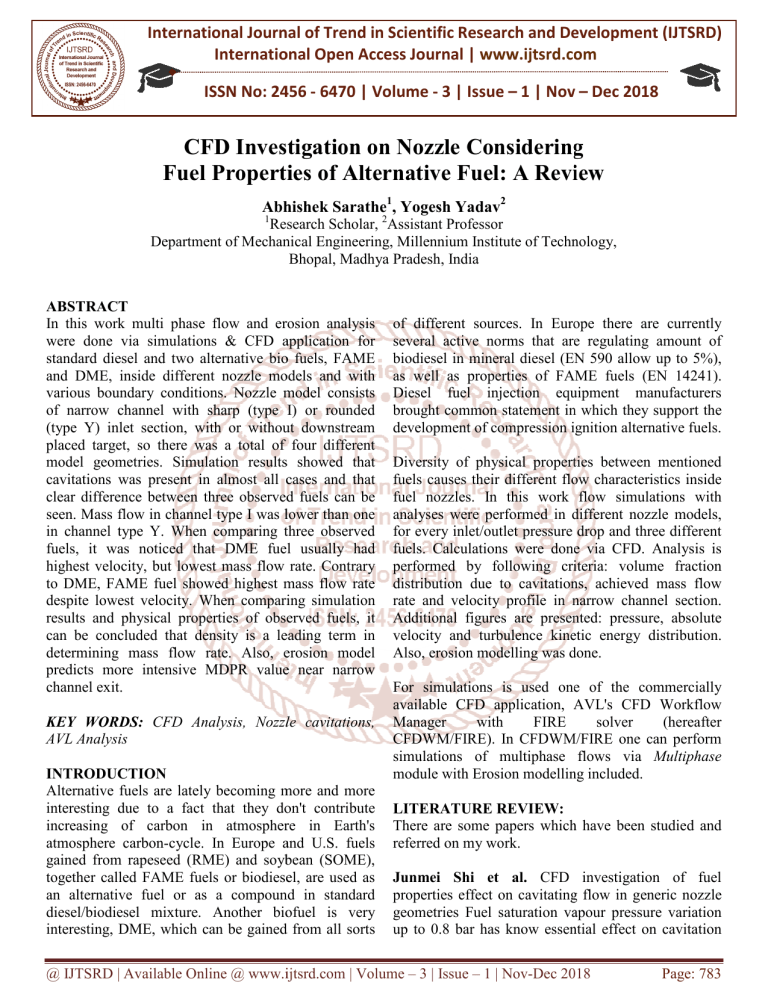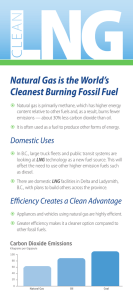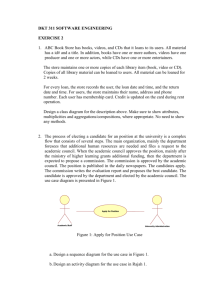
International Journal of Trend in Scientific Research and Development (IJTSRD)
International Open Access Journal | www.ijtsrd.com
ISSN No: 2456 - 6470 | Volume - 3 | Issue – 1 | Nov – Dec 2018
CFD Investigation on
n Nozzle Considering
Fuel Properties of Alternative Fuel:: A Review
Abhishek Sarathe1, Yogesh Yadav2
1
Research Scholar, 2Assistant Professor
Department of Mechanical Engineering, Millennium Institute of Te
Technology
chnology,
Bhopal, Madhya Pradesh, India
ABSTRACT
In this work multi phase flow and erosion analysis
were done via simulations & CFD application for
standard diesel and two alternative bio fuels, FAME
and DME, inside different nozzle models and with
various boundary conditions. Nozzle model consists
of narrow
rrow channel with sharp (type I) or rounded
(type Y) inlet section, with or without downstream
placed target, so there was a total of four different
model geometries. Simulation results showed that
cavitations was present in almost all cases and that
clear difference between three observed fuels can be
seen. Mass flow in channel type I was lower than one
in channel type Y. When comparing three observed
fuels, it was noticed that DME fuel usually had
highest velocity, but lowest mass flow rate. Contrary
to DME,
E, FAME fuel showed highest mass flow rate
despite lowest velocity. When comparing simulation
results and physical properties of observed fuels, it
can be concluded that density is a leading term in
determining mass flow rate. Also, erosion model
predicts more
ore intensive MDPR value near narrow
channel exit.
KEY WORDS: CFD Analysis, Nozzle cavitations,
AVL Analysis
INTRODUCTION
Alternative fuels are lately becoming more and more
interesting due to a fact that they don't contribute
increasing of carbon in atmosphere in Earth's
atmosphere carbon-cycle.
cycle. In Europe and U.S. fuels
gained from rapeseed (RME) and soybean (SOME),
together called FAME fuels or biodiesel, are used as
an alternative fuel or as a compound in standard
diesel/biodiesel mixture. Another biofuel is very
interesting, DME, which can be gained from all sorts
of different sources. In Europe there are currently
several active norms that are regulating amount of
biodiesel in mineral diesel (EN 590 allow up to 5%),
as well as properties of FAME fuels (EN 14241).
Diesel fuel injection equipment manufacturers
brought common statement in which they support the
development of compression ignition alternative fuels.
Diversity of physical properties between mentioned
fuels causes their different flow characteristics inside
fuel nozzles. In this work flow simulations with
analyses were performed in different nozzle models,
for every
very inlet/outlet pressure drop and three different
fuels. Calculations were done via CFD. Analysis is
performed by following criteria: volume fraction
distribution due to cavitations, achieved mass flow
rate and velocity profile in narrow channel section.
Additional figures are presented: pressure, absolute
velocity and turbulence kinetic energy distribution.
Also, erosion modelling was done.
For simulations is used one of the commercially
available CFD application, AVL's CFD Workflow
Manager
with
FIRE
solver
sol
(hereafter
CFDWM/FIRE). In CFDWM/FIRE one can perform
simulations of multiphase flows via Multiphase
module with Erosion modelling included.
LITERATURE REVIEW:
Theree are some papers which have been
be studied and
referred on my work.
Junmei Shi et al. CFD investigation of fuel
properties effect on cavitating flow in generic nozzle
geometries Fuel saturation vapour pressure variation
up to 0.8 bar has know essential effect on cavitation
@ IJTSRD | Available Online @ www.ijtsrd.com | Volume – 3 | Issue – 1 | Nov-Dec
Dec 2018
Page: 783
International Journal of Trend in Scientific Research and Development (IJTSRD) ISSN: 2456-6470
2456
this is due to the very high pressure gradient caused
by the flow acceleration in the nozzle.
Takenaka et al. CFD analysis of nozzle cavitations
Investigation of cavitation phenomena showed that for
nearly all the duration of the injection process the
nozzle
zzle injector hole is surrounded by cavitation films
films.
Berchiche et al For interfacial mass exchange Linear
Cavitation Model was used and for interfacial
momentum exchange Cavitation Drag Model was
used. Both interfacial exchange models imply two
additional transport equations: Bubble Number
Density and Interfacial Area equation. These
equations bring up additional closure coefficients of
mathematical model.
Semelsberger et al FAME
AME fuel achieves highest mass
flow rates in all cases. DME has lowest mass flow
rates. Generally, mass flow rates in Channel Y cases
are higher than ones in Channel I cases for same
boundary conditions. Both interfacial exchange
models imply two additional transport equations:
Bubble Number Density and Interfacial Area
equation. Thesee equations bring up additional closure
coefficients of mathematical model.
Ornella Chiavola et al On a modified VCO nozzle
layout for diesel common rail injectors under actual
needle displacement FAME fuel achieves highest
mass flow rates in all cases. DME has lowest mass
flow rates. Generally, mass flow rates in Channel Y
cases are higher than ones in Channel I cases for same
boundary conditions.
METHOD USED
In this work quasi-stationary,
stationary, inner, non
noncompressible, viscous, turbulent
ent and two
two- phase
(generally multiphase) type of flow is assumed, so
simulation
is
set-up
up
considering
these
assumptions. Two-phase
phase flow implies bubble
number density and interfacial area between liquid
and gas phase, so additional transport equations
for modelling cavitation should be active in order
to describe phase change.
All conservation equations can be written in
generic
eneric form Turbulence model is a part of a Eddy
Viscosity Models (EVM) with two equations
EVM assumes direct analogy between molecular
and turbulent momentum. Based oon Boussinesq
assumption.
Erosion is in Multiphase module modelled within
two model quantities
ties Erosion Incubation Time
Mean Depth Penetration Rate (MDPR)
Dimensions that are strictly defined: nozzle model
thickness, narrow channel, target and height (y
coordinate). Length (x coordinate) of inlet and
outlet zone is not strictly defined and should be
selected to give developed flow on inlet and outlet
zone Calculation stability is also affected with
these parameter.
Because of overall of four different nozzle model
types, and computational domains respectively,
hereafter computational domains will be referred
as:
• Channel I → channel type I without target
• Channel Y → channel type Y without target
• Target I → channel type I with downstream
placed target
• Target Y → channel type Y with downstream
placed target
SELECTIONS AND BOUNDARY CONDITIONS
COND
All domain meshes have same number and type of
selections. Boundary conditions must be defined for
every phase separately, except pressure which is
coupled variable and is defined only for continuous
phase. Also, total of phase volume fractions must be
equal to one. Since driving force for flow quantities is
pressure difference between inlet and outlet
ou
selection,
in order to avoid too long mesh on inlet zone, flow
direction on inlet selection is determined. Boundary
turbulence parameters were pre-defined
pre
by AVL.
CONCLUSIONS
CFDWM/FIRE application can give us valuable data
regarding multiphase cavitating
tating flow inside nozzles. it
is shown that mathematical model is valid for its
purpose and that nozzle flow for different fuels can be
done. when comparing different fuels simulation
results, some obvious differences can be observed.
Most significant conclusion
sion regarding to comparison
between fuels is that in mass flow rate equation, fluid
density is more significant term than molecular
viscosity. This is concluded based on fact that in
almost all cases DME fuel had highest velocity but
lowest mass flow rate.. If we combine that with fluid
properties above conclusion can be derived.
REFERENCES
1. Hammond G.P., Kallu S., McManus M.C.,
Development of biofuels for the UK automotive
market,, Applied Energy, 2006.
@ IJTSRD | Available Online @ www.ijtsrd.com | Volume – 3 | Issue – 1 | Nov-Dec
Dec 2018
Page: 784
International Journal of Trend in Scientific Research and Development (IJTSRD) ISSN: 2456-6470
2456
2. Mulqueen S., The European Alternative Fuel
Market And The Role Of Fuel Additives
Additives, Biofuels
Conference, Greece 2007
3. Diesel Fuel Injection Equipment Manufacturers
Common Position Statement, Fatty Acid Methyl
Ester Fuels As a Replacement or Extender for
Diesel
Fuels,
2004,
published
on:
http://www.ufop.de/downloads/FAME_Statement
_June_2004.pdf
4. AVL FIRE v.8, Multiphase Flow
Flow, AVL, Graz,
2004
5. AVL FIRE, New Cavitation Model: a parametric
variation of coefficients,, AVL, Graz, 2006
6. Greif D., Wang D.M., Aspects Of Modelling
Cavitation Effects Within Injecton Equipment
Using
Advanced
Two-Fluid
Fluid
Techniques
Techniques,
Turbulence, Heat and mass transfer 5
7. Hanjalić K., Dinamika stišljivog fluida,
fluida 1970
8. Franjić, K., Hidraulički
ki strojevi i postrojenja,
postrojenja FSB
scrypt
9. Asi O., Failure of a Diesel Engine Injector Nozzle
by cavitation damage,, Engineering Failure
Analysis, 2006.
10. ASM handbook, vol. 13, Corrosion. Metals Park
(OH): American Society for Metals; 1987.
11. ASM handbook, vol. 18, Friction, lubrication, and
wear technology. Metals Park (OH): American
Society for Metals; 1992.
12. ASM handbook vol.11., Failure Analysisi and
prevention, 1986
13. Dular M., Bachert B., Stoffel B., Sirok B..
Relationship between cavitation structures and
cavitation damage,, Wear, 2004
@ IJTSRD | Available Online @ www.ijtsrd.com | Volume – 3 | Issue – 1 | Nov-Dec
Dec 2018
Page: 785





